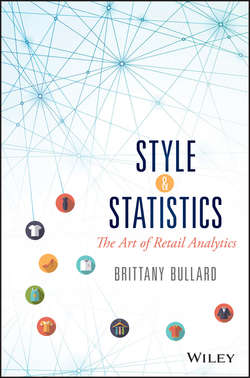Читать книгу Style and Statistics - Bullard Brittany - Страница 8
Chapter 2
Merchandise Financial Planning
ОглавлениеAssortment” is a term used to describe the product offerings carried by a retailer. Managing this assortment is a critical piece to creating a successful and profitable business. This assortment needs to change with the seasons. It needs to change with the recent fashion trends and consumer trends. Assortments need to reflect what is going on in the marketplace. If people are no longer buying Kodak cameras or overalls, then you definitely don’t want them in your assortment. But assortment management is also about having a business plan and meeting financial goals. At the end of the day, no matter how beautiful an assortment is, it has to drive profitability for a retailer or designer to stay in business.
Management of assortment starts at a high level. Specific financial targets must be met. Quite often, these high-level initial targets are determined by a finance department. Companies have certain targets that must be met to keep the lights on, keep investors happy, and make money. Finance departments typically determine a high-level annual revenue target. From there, a planning and allocation team typically takes that number from finance and breaks it down to consumable and actionable levels.
We call these levels hierarchies. A “hierarchy” by definition is a ranking system where items are classified into different levels. From a merchandising hierarchy perspective, three different hierarchies are utilized. One hierarchy is for merchandise, the second hierarchy is location based, and the third is time. People in retail also refer to this as MLT (merchandise, location, and time). The merchandise hierarchy naming and ordering convention can vary by retailer. Typically it starts at the top with “total company.” This could then be followed by division or category.
A total company can be divided up into different higher-level businesses. For example, in a department store, these divisions could be: men’s, misses’, petite, plus/women’s, juniors, young men’s, boys, girls, baby, shoes, accessories, and home. The next level under a division is typically a department. These departments are lower-level segments of a division. Let’s take misses’ as an example. Within misses’, the lower-level segments of the department could be tops, warm wear, bottoms, dresses, and swim. The next level typically is a major class. Examples of major classes within misses’ tops could be long-sleeve tops, short-sleeve tops, and tanks. Some retailers may even take it a next level lower, to subclasses. Below that is the style. Each style of shirt falls under these hierarchical designations, followed by the style in specific colors, which is called a style-color or lot, and then the style-color is organized by size. The lowest level of style-color-size is most often referred to as a SKU, which stands for “stock keeping unit.” The SKU often represents the item and has a designated barcode used to track sales and inventory.
The typical definition of a location hierarchy has changed over the years as e-commerce has grown. Typically, it begins with the total company. If there are different brands, they could follow the total company. Below a brand could possibly be the brick-and-mortar channel and the direct-to-consumer channel, also known as DTC. DTC is another tricky term that can vary widely by retailer. It is the business channel that includes e-commerce. Retailers may also have a wholesale channel of business that sells directly to third-party resellers, such as T.J. Maxx, Ross, department stores, or other outlet stores. Within the location hierarchy, these channels can then be further broken down to lower levels of detail. The brick-and-mortar channel can be broken down by country. Within a country, it can be broken down by region, followed by state and other levels to describe the hierarchy until the lowest level of specific store/location. These stores are assigned a store number along with a store name.
Time has a much more standard hierarchical naming convention. Typically, time starts with a fiscal year. Fiscal is, by definition, an adjective used to describe a noun that is related to government revenue or taxes. The fiscal year of many retailers aligns with the calendar year, starting in January and ending in December. Some retailers, however, have fiscal calendars that do not align with the calendar year. For example, the first fiscal month of the year may be August and the last month is July; or the year may start in February and end in January. The fiscal year can then be broken down into season and/or quarter, followed by month and then week. Very few retailers plan by day, but it could happen. More power to them!
Okay, so now that we have established all of the many different hierarchy levels included in merchandise, location, and time, let’s talk about how these are used. As I mentioned earlier, a company’s finance department typically determines the highest level of financial targets. Finance is a division within an organization. The planning and allocation team is typically a separate team that is responsible for planning the business at a lower level, tracking performance, reacting to changes, and driving the business forward. This team can also differ in their exact naming convention by retailer, but their roles and responsibilities are typically standard.
Once the planning and allocation team receives the overall financial target, they then create a financial plan at the lower levels of the merchandise, location, and time hierarchy. They do this in order to better understand the business, react to trends, find risks and opportunities, and quickly react or course correct. The merchandise planners create a financial and strategic plan that includes key performance indicators, or KPIs. KPIs are metrics that indicate the performance of the business. These concepts and activities are known as merchandise financial planning.
Конец ознакомительного фрагмента. Купить книгу
